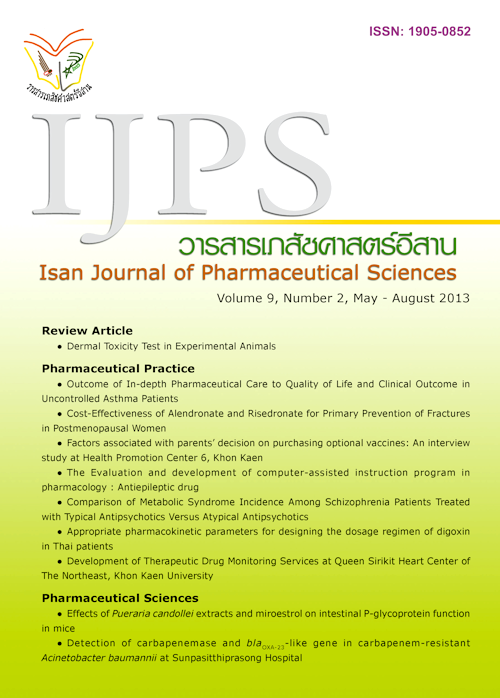Dermal Toxicity Test in Experimental Animals
Main Article Content
Abstract
Dermal toxicity causes by several reasons such as air pollution, exposures to extremely high or low-pH chemicals, x- or gamma-rays, sunlight, and cosmetics. Duration and amount of exposure to any substances are additional reasons of dermal toxicity. Therefore, the testing of dermal toxicity is required as a risk-benefit assessment of a topical product for human safety. Dermal toxicity testing can be classified according to different impacts of the test substance by ascending severities as follows: irritation, sensitization, corrosion, acute dermal toxicity, subchronic dermal toxicity, and chronic dermal toxicity, respectively. Herewith the guidelines and precautions for testing and evaluation of each levels of the dermal toxicity in experimental animals have been reviewed.
Article Details
In the case that some parts are used by others The author must Confirm that obtaining permission to use some of the original authors. And must attach evidence That the permission has been included
References
Department of Toxicology, Shriram Institute for Industrial Research Skin Sensitization Study on Guinea Pig with NHH 44 Bt-Cotton Seeds. Shriram Institute for Industrial Research 2007; 41401.
Depass LR, Fowler EH, Leung HW. Subchronic Dermal Toxicity Study of Triethanolamine in C3H/HeJ Mice. Food and Chemical Toxicology 1995; 33(8): 675-680.
Elias PM. Epidermal Lipids, Barrier Function and Desquamation. Journal Investigative Dermatology 1983; 80: 44-49.
Elias PM. Epidermal Barrier Function: Intercellular Lamellar Lipid Structures, Composition and Metabolism. Journal of Controlled Release 1991;.15(3): 199-208.
Gawkrodger DJ. Dermatology: An Illustrated Colour Text. 2nded. Edinburgh: Churchill Livingstone; 1997.
Gawkrodger DJ. Dermatology: An Illustrated Colour Text. 3rded. Edinburgh: Churchill Livingstone; 2002.
Isbrucker RA, Edwards JA, Wolz E, et al. Safety Studies on Epigallocatechin Gallate (EGCG) Preparations. Part 2: Dermal, Acute and Short-Term Toxicity Studies. Food and Chemical Toxicology 2006; 44: 636-650.
Monteiro-Riviere NA. Introduction to Histological Aspects of Dermatotoxicology. Microscopy Research and Technique 1997; 37(3): 171.
Monteiro-Riviere NA. Dermatotoxicology. In: Smart RC, Hodgson E, editors. Molecular and Biochemical Toxicology. Toronto: John Wiley & Sons; 2008. 851-880.
OECD. Repeated Dose Dermal Toxicity: 21/28-day Study. OECD Guideline for the Testing Chemicals 1981; 410.
OECD. Subchronic Dermal Toxicity: 90-day Study. OECD Guideline for the Testing Chemicals 1981; 411.
OECD. Acute Dermal Toxicity. OECD Guideline for the Testing Chemicals 1987; 402.
OECD. Acute Dermal Irritation/Corrosion. OECD Guideline for the Testing Chemicals 1992; 404.
OECD. Skin Sensitisation. OECD Guideline for the Testing Chemicals 1992; 406.
OECD. Acute Dermal Irritation/Corrosion. OECD Guideline for the Testing Chemicals 2002; 404.
OECD. Skin Sensitisation: Local Lymph Node Assay. OECD Guideline for the Testing Chemicals 2002; 429.
OECD. Chronic Toxicity Studies. OECD Guideline for the Testing Chemicals 2009; 452.
OECD. Combined Chronic ToxicityCarcinogenicity Studies. OECD Guideline for the Testing Chemicals 2009; 453.
OECD. Skin Sensitisation: Local Lymph Node Assay. OECD Guideline for the Testing Chemicals (Draft Proposal for an Updated Test Guideline) 2009; 429.
OECD. Skin Sensitisation: Local Lymph Node Assay: DA. OECD Guideline for the Testing Chemicals 2010; 442A.
Ro BI, Dawson TL. The Role of Sebaceous Gland Activity and Scalp Microfloral Metabolism in the Etiology of Seborrheic Dermatitis and Dandruff. Journal of Investigative Dermatology Symposium Proceedings 2005; 10(3): 194-197.
Schmidt-Nielsen K. Scaling, Why Is Animal Size So Important?. New York: Cambridge University Press; 1984.
Suskind RR. The Skin: Predictive Value of Short-Term Toxicity Tests. In: Bourdeau P, editors. Short-Term Toxicity Tests for Non-genotoxic Effects. Toronto: John Wiley & Sons; 1990. 155-175.
Suskind RR. Environment and the Skin. Environmental Health Perspectives 1997; 22(1): 27-37.
United Nations Economic Commission for Europe (UNECE). Globally Harmonized System of Classification and Labeling of Chemicals (GHS). 3thed. United Nations Publications; 2009.

